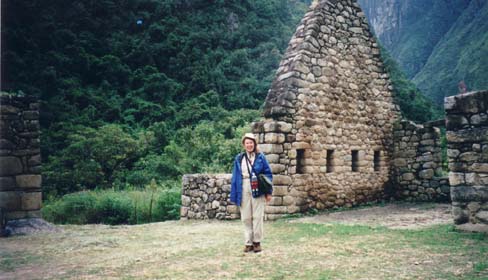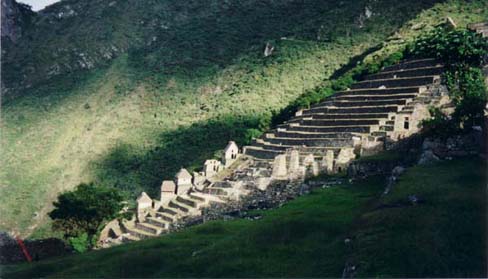We heard the band sporadically throughout the night, as they marched and passed under our window. It got so loud at points that we just started laughing. Craig heard the last drummer going home around 2 a.m. Despite all of this, we did get a good night's sleep. Guess we're getting used to Peru!
We got up at 5:30 and had a breakfast of scrambled eggs, juice, bread, and jelly at 6:15. Vidal met us and we took a taxi to the train station. We asked Vidal if we'd have to pay extra for last night's "entertainment" and he said he had thought the music had all been a nightmare. Vidal had been able to exchange our 9 a.m. train tickets for 7 a.m. tickets (we had to pay extra, but it was worth it to get an early start). The train was one large comfortable car. There was snack and beverage service. Craig and I pocketed our small ham and cheese sandwiches for later. Craig got coca tea. I was just thinking that it was strange that all of the plates, cups, bowls, etc. were ceramic on such a windy train ride when SMASH! A tray full of perfectly stacked cups and plates crashed to the floor, shattered. This would happen one more time on the course of our 1.5 hour train ride. I have one word for you, PeruRail: plastics.
We got out at km 104, crossed a bridge over the Urubamba, and went to the checkpoint. As our papers weren't in order, they would not let us hike the trail. We looked at the Chachabamba ruins (which had very steep roofs) and then hiked along another trail which parallels the Urubamba. It was very much a cloud forest here. We saw a blue crowned marmot, a bird with an iridescent blue head. It was a great hike that passed some local houses. After about 6 km we reached some ruins that are not yet open to the public. There are archaeologuists actively working there. It was intense, and we walked through one of the sites. Vidal's plan was to continue on the trail, which will eventually bring us to Whinyhuayno, and meet up with the Inca Trail. If noone gave us a hard time we could continue up the Inca Trail to Machu Picchu. Vidal was miffed because although they had told us we couldn't follow the Inca Trail the whole way up to Machu Picchu, they said we could follow it from Machu Picchu back down, which didn't really make any sense if they were trying to control the number of people on the trail. But anyway, we got turned around almost immediately after these ruins, so we hiked the 6 km back to km 104.
Vidal said that we could catch the next train to Aguas Calientes, drop off our stuff, and go to Machu Picchu if we wanted to. We waited about 15 minutes for the train, but the next train to arrive was a local train. Tourists are not allowed on local trains. They can only take the highly priced tourist train. In this case, we had an expensive tourist train ticket, but only wanted to catch the local train as quick transport to the nearby Aguas Calientes. Carlos had told us on the first half of the trip that they had recently instituted this policy, and that lots of tourists were upset, because they'd rather ride a train with Peruvians than just with other tourists. We got on the local train and stood near the door. There wasn't much room, and I ended up balanced over a sack of potatoes. The conductor was none too pleased to see gringos on his train, and Vidal needed to explain. The guy took our passport info and asked us some questions . Then another conductor came along and saw us, and immediately questioned us. The other guy explained he had taken down our info. It was a bit nerve-wracking, and we got to Aguas Calientes none too soon. When we stepped off the train a stern looking security guard looked us up and down. The conductor said something to him and he let us go. We walked down to our hotel and checked in. The proprietor was very nice and offered us our choice of rooms. We chose a room that had a queen bed and a balcony overlooking the Urubamba. The roar of the river was intense from the room. Only one day of Machu Picchu was included in the tour, so we bought bus tickets ($9 apiece) and entrance tickets ($20 apiece) so that we could visit Machu Picchu today as well.
The bus crossed the river and then went up a series of switchbacks until it reached Machu Picchu. It took about half an hour. The entrance fee seemed very high compared to other Peruvian attractions we had seen, but you could tell the money was going into restoration. There were lots of workers with sickuls and machetes cleaning weeds and grass from in between stones. Machu Picchu was short on guides that day. They asked Vidal if he could take on another couple of people. He said no but they kept asking him. His love of guiding and teaching people about Peru eventually led him to ask us if it was OK. We said of course. So a family from L.A. (mother, father, adult son) joined us. The son had just completed two years as a missionary in Chile. It was cloudy at first but later the sun shone through. We wandered the ruins from 1:30-5:00, with Vidal giving us invaluable information. In my opinion, the most impressive thing was the Temple of the Condor. It was a temple where mummies were placed. The walls looked like condor wings, and there was a carved stone on the ground that looked like a condor body, with head, eyes, and white neck collar. However, when you stand behind it, it looks to be the exact shape of South America (with a vein running right where the Amazon River would be). There are other rocks where Central America, Mexico, and Easter Island would be (and Easter Island architecture is very much like Peruvian and could be related). It just blew my mind. How much did the Incas know in their day? Their world view seems so broad. What would they have achieved by now if the Spaniards had not wiped out their culture? There were some llamas on the various terraces. What really struck me about Machu Picchu is that from the pictures I had seen in text books, etc., I never realized how tall the ruins were. I kind of expected all of the walls to be about two feet tall, really ruins. But most of the structures are very much intact, and walls are taller than we are. I don't think that really comes across in pictures taken from above. Vidal pointed out some of the old (bad) restoration that had been done. They replaced some damaged lintels with wood (not used in authentic Inca contruction), and they also used cement to replace some missing stones. At least with the high entrance costs today things are monitored and the restoration taking place now is more authentic.While touring the ruins we saw a hummingbird, a large millipede, sparrows, a lizard, and a fer de lance (poisonous snake). We took a bus down to Aguas Calientes at 5:15. Chaskis used to be messangers in Inca times. Today, little boys dress up in chaski outfits. As a bus leaves the top of the mountain, they run down stairs and meet the bus at each switchback yelling "g-ooooooooooooo-d-b-yyyyyyyyyy-eeeeeeee" and "aaaaaa-di-oooooooooooos!" and waving at the bus. At the bottom of the mountain the busdriver lets the boy on and he collects tips from the passengers. They really work for their money, as they look absolutrely exhausted after running down the mountain.
We wandered through Aguas Calientes. We saw a really neat metal statue in the Plaza de Armas that depicted a condor and all kinds of Peruvian historical symbols. Some young local boys were playing with tops near it, and Vidal told them a little bit of the history. We ate at the Tucano restaurant. We were the only ones there. We sat inside near a window, and also near the stone oven. Craig and I ordered a hot sausage and pepper pizza. Vidal put his ham and cheese sandwich (from this morning's train ride) into the pizza oven. When it came out all nice and toasted, he shared it with us.Some musicians were walking by in the street, and there was a guy with a gorgeous harp. I pointed to him to show Craig. Never point in Peru unless you are really interested in something. The guy saw me point and got a big smile on his face. About five minutes later I looked out the window and he was still there staring at us, smiling. He said something to the proprietor and the proprietor asked if we'd like some live music. We said sure. The guy hastily put on a pancho and hat and ran in the door. A young woman followed and set up a table with a CD and a little doll of a guy playing the harp. The music was fantastic. The guy (whom we learned was Juan Quispe Patiño) was very talented and the harp had a superb sound. He played "El Condor Pasa", and then the girl played a song. They then played a song together (each using only one hand). It was beautiful. We heard about 4 or 5 songs total, and then we bought his CD for 35 soles. He was very appreciative. We went back to the hotel at 8:30.
|









|






